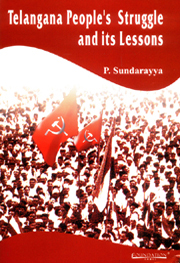Book contents
- Frontmatter
- Contents
- Preface
- Introduction
- PART I
- 1 Hyderabad State—its Socio-Political Background
- 2 The Peasant Upsurge and Communist Party
- 3 Armed Resistance Movement Against Nizam and Razakars
- 4 Telangana People's Armed Liberation Struggle Against Nizam – its Achievements
- 5 The Communist Movement in Andlira: Terror Regime—1948–1951
- PART II
- PART III
2 - The Peasant Upsurge and Communist Party
from PART I
Published online by Cambridge University Press: 05 November 2011
- Frontmatter
- Contents
- Preface
- Introduction
- PART I
- 1 Hyderabad State—its Socio-Political Background
- 2 The Peasant Upsurge and Communist Party
- 3 Armed Resistance Movement Against Nizam and Razakars
- 4 Telangana People's Armed Liberation Struggle Against Nizam – its Achievements
- 5 The Communist Movement in Andlira: Terror Regime—1948–1951
- PART II
- PART III
Summary
During the whole period of 1940–1944, the Party and the left cadre of the Andhra Mahasabha carried on agitation and made representations, to see that the firmans of the Nizam that favoured the people were put into practice and not sabotaged by the landlords and the corrupt officials. This enabled it to gain a wide popular image and the left wing led by our Party took over the leadership of the Andhra Mahasabha.
Since the beginning of 1944, the Andhra Mahasabha under the leadership of the Communist Party conducted many militant struggles against zamindars and deshmukhs, against the practices of vetti (beggar – forced labour), against illegal exactions and against evictions of cultivators from their lands.
Below are a few incidents from a narrative by a leader and participant in those struggles, that would give an idea of the mood and militancy of the peasant masses in Telangana at the beginning of the postwar period. Many such struggles carried on in Khammam, Warangal and Karimnagar districts or in other areas can be narrated by the participants but, unfortunately, we do not have, at present, any record of even the important mass struggles of these areas. But the events that are narrated here would illustrate the point.
1. In Dharmapuram Jangaon taluka (Nalgonda district), zamindar Pusukuri Raghavarao sent his goondas to drive away the tribals from the Lambadi tanda (hamlet of the Lambadi people, a backward tribal community), who had in their possession 80 acres of dry and 25 acres of wet land.
- Type
- Chapter
- Information
- Telengana People's Struggle and it's Lessons , pp. 19 - 39Publisher: Foundation BooksPrint publication year: 2006

